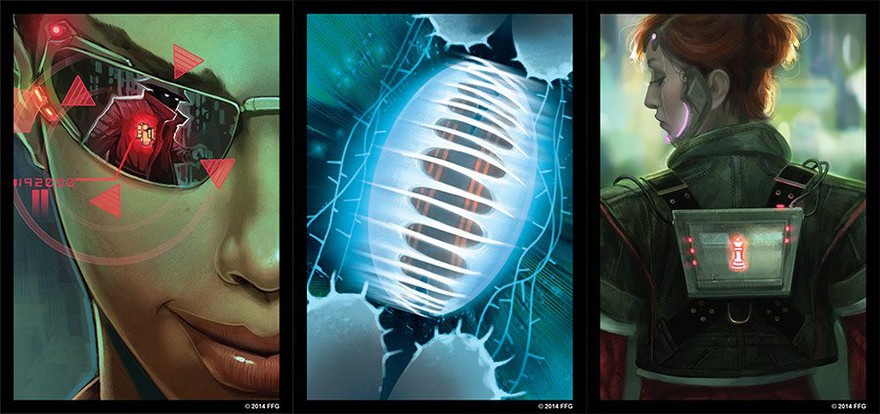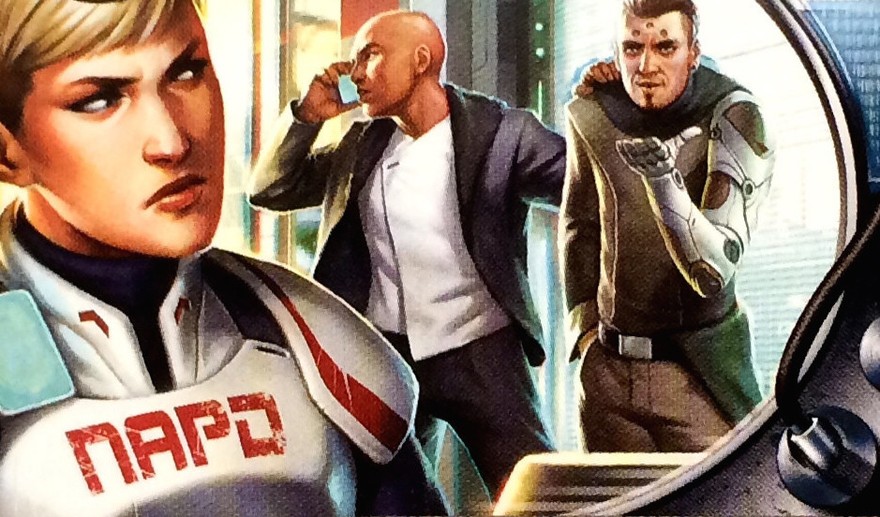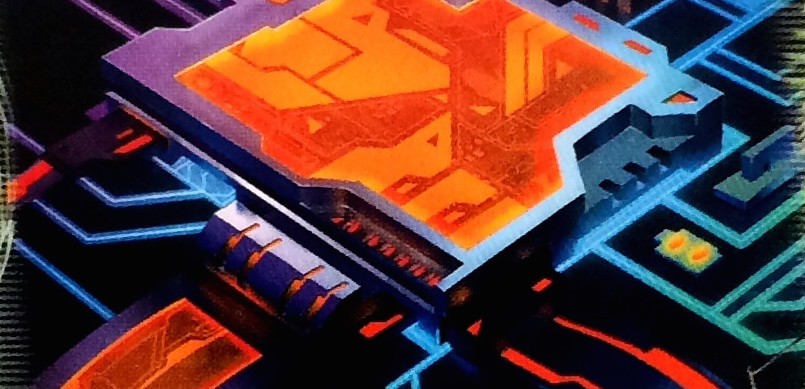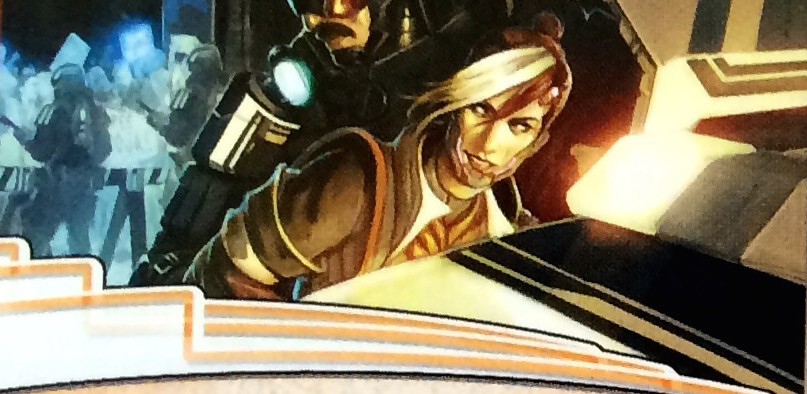01. When the card game Android: Netrunner was released in 2012, it had three cycles of cards planned out. As the last of these cycles neared completion, the dedicated player base was fervently speculative about what would come next, if anything. Where could our game go from here, complex yet seamless as we found it, without becoming repetitive or engorged with cards?
02. After a year and some change, my Netrunner nemesis is dead to me. Known around the office as “Yeti,” he’s abandoned our lunchtime grudge matches for upward mobility and better financial compensation. Maybe it’s time to step away and give up on finding new rivals.
03. I haven’t played Magic: The Gathering since my only deck was stolen from a swimming pool locker. I was seventeen and now freed from collecting cards to learn more Local H and Rage Against the Machine songs on guitar.

04. Netrunner is going to California. Specifically, the fictional near-future megacity known as SanSan, which swallows the state from San Diego to San Francisco. New cards will continue to be printed through what is called the SanSan cycle and beyond, but can its designers keep things fresh, rather than simply slapping new art on old ideas?
05. Kill Screen: I browbeat a friend of mine into playing with me and we’ve played essentially every day at lunch for more than a year.
Android: Netrunner designer Lukas Litzsinger: That sounds awesome.
KS: It was the perfect setup until he got a new job. [laughs] Which is really rude of him.
LL: How inconsiderate!
06. You can’t really talk about Netrunner without the unholy dragons of Magic flittering overhead. Both are two-player card games with customizable decks where each player is trying to bluff and out-strategize the other. Both games were originally created by Richard Garfield, though the Netrunner being played now was resurrected Fantasy Flight Games, redesigned by Lukas Litzsinger, and has become the game equivalent of your favorite band’s favorite band: loudly celebrated, quietly intimidating.
07. Magic is a collectable card game, and Netrunner is a “Living Card Game”: the difference is that the expansions for Netrunner aren’t random. Other Living Card Games include FFG’s own Game of Thrones and Star Wars, as well as Paizo’s Pathfinder Adventure Card Game. In all of these, as in Netrunner, you know what you can get in each expansion, and you can purchase just what you want without relying on Fortune’s blessing. Buying every pack is an option, but not a requirement to stay competitive.
08. Magic has also been around quite a while, where FFG’s Netrunner is comparatively natal. Netrunner has gleaned much from Magic about how to keep the scene alive and thriving, newcomers welcomed and interested, while working to reduce stagnation and toxic attitudes. Without the collectable, random-purchase element to drive interest, Netrunner relies on the creativity of its players, their continued investment in its mechanics and aesthetics, as well as their own positive vibes to keep the game alive.
09. To win a game of Netrunner, Corporations score agenda points and Runners steal them, though there are other conditions for winning and losing on both sides. Yeti’s Corp deck is built around “Biotic Labor,” a card used to score agenda points straight from his hand, so he doesn’t have to take the risk of installing and exposing them on the board. This is called “fast-advancing,” and I hate it, at least until we switch sides. Then my moral qualms buckle like a bored artificial intelligence waiting for a runner to just shoot the shit for a click or two.

10. I interviewed Litzsinger to ask about how he intends to keep this Living Card Game alive. A part of that is, obviously, to continue developing cards, but Litzsinger isn’t only about pushing inked paper. He’s remained dedicated to Netrunner as a game with a compelling narrative framework. Thus we have the SanSan cycle, a series of expansions that confronts established strategies while drilling down on the chronicle of SanSan: Hollywood, undergraduate activism, Silicon Valley, and the regular people caught in the flak of the cyberwar.
11. LL: [SanSan] was the first [cycle] where we wanted to kind of have a theme come through in each pack, and we designed each pack individually from the get-go rather than splitting it up afterward.
12. By the time my deck had been stolen, Magic had become a chore. I wasn’t willing to shoplift cards like James, the older guy who gave us rides around town for a quarter. I couldn’t really afford to buy enough blind packs to compete. So while I enjoyed the game, I was blithely handed the dregs and treated as a training dummy, which got old quick.
13. LL: You don’t really want a silver bullet that nerfs a specific card, but by creating counters you are actually helping to introduce a “meta”—a term to describe the various player bases of Netrunner, from the hyper-local to the national and world stages—where you can choose to play those counters if you’re worried about that matchup at the cost of a little bit of consistency in the rest of your deck. And so for players who are worried about their match up against a fast-advance deck they can start packing some of these tools into their own deck in response.
14. Where Magic disappeared from my life with nary a second thought, Netrunner haunted me before I ever played a turn. The art, language, asymmetry, online chatter and write-ups—it sucked me in to the point where I bought cards without any clear plan on finding anyone to play with. Luckily Yeti was up for any game I brought in to the lunch room.
15. Each expansion, from the Core set through the Deluxe sets and smaller Data packs, includes a taste for almost every faction of Runners and Corporations. When I started there were already a lot of cards, with more added monthly, so I was concerned about being overwhelmed. Yet, after a game or two, when the individual cards and actions became familiar, the complexity melted away and the underlying dance of intrusion and counter-intrusion mesmerized me.
16. KS: In what ways do you manage all of these potential card interactions?
LL: That’s a really good question. You’re never going to foresee all situations, all possibilities, all ends; you can only try to get as close as possible. I think as the game has gone on we’ve done a better job of finding the sweet spot for cards, where they’re not too powerful and they’re not too weak. They’re kind of right in the middle, where you want to use them but you’re finding that it’s hard to fit them into your deck. But you really want to fit them into your deck because they work with these other cards. ??

17. Lukas Litzsinger is as approachable as he is dedicated to Netrunner. He is the highest arbiter of rules and card conflicts, though obviously he and his team can’t possibly anticipate or playtest every card interaction before moving forward.
18. LL: You’re never going to foresee all situations, all possibilities, all ends, you can only try to get as close as possible … It’s a small sample size compared to the hundreds and hundreds of games that the players will be able to play with it once it’s released. But you get as close as you can, and I think that playtesting is the way that you make sure nothing slips through that is going to imbalance the game, or make that deck-building choice too easy.
19. When a new pack is released, the meta runs Litzsinger’s new cards ragged, then they tweet or email their concerns to him. His rulings are the last word. But the players have their own sense of ownership, expressed by designing custom tokens, interactive Twine visual novels to help explain the rules of the game, multiplayer variants, and so on. Litzsinger isn’t himself focused solely on mechanics over presentation either.
20. LL: There’s two ways that you can go about starting to design a card. There’s the top down, which is beginning with a theme and then trying to extrapolate out of that theme, or out of that idea, or out of that nugget of reality, some mechanic. And then there’s the bottom up or mechanical approach: where you start with a game idea and then you try to figure out where that actually fits into the world that you are creating. I usually employ a combination of the two. It depends on the card and it depends on just where the idea came from.
21. Recently NPR’s Planet Money did a radio piece on the longevity of Magic, with twenty-plus years of tapped mana and summoned creatures. Born in the era when pogs, Beanie Babies, #1 issues of comics, and so much more burst their bubbles, Magic survives by splitting its time between collectability and playability.
22. My old Magic deck was as worthless on the table as it was behind glass, or rather in a binder.
23. Magic tournaments are known for being intensely competitive, because there are professional players and money is often on the table. As such many (but certainly not all) Magic players don’t have the time or patience for newcomers. Netrunners regularly come to the game after a breakup with Magic, tired of the min/max grind, aping winning deck lists, and paying to win. They have more creative aspirations.
24. Though I haven’t done it very much, teaching Netrunner is a joy. I love when people glom onto the combinations, make plans and follow them through, appreciate how their cards twirl with mine. Each game lays another brick in the world of Netrunner. Yeti’s leaving but I want to keep playing, to see the sights of SanSan and beyond. That means figuring out the archaic, unreliable, and unofficial online variants, talking other friends into giving it a shot, or going out into the real world to find new opponents.

25. I found a casual meet up: time to take these decks out into the world and embrace my destruction. The other guys who arrive are ex-Magic players, and both find Netrunner’s community to be much more inclusive, patient, and fun. Neither of them is a slouch at this game, though, and while tokens fly and subroutines are broken, we each help bookkeep the various stores of credits and hosted viruses like gentlemen.
26. LL: I think the positivity around the Netrunner community in general, and the good sportsmanship I’ve seen, is exciting. I do think part of it might be the lack of cash prizes, for example. You have your pride on the line, you have your own competitive spirit on the line whenever you enter a tournament, but it’s not going to make or break your next rent payment if you win or lose.
27. My Shaper deck is significantly behind the times as far as expansions go, but I’m invigorated to discover it still melts ICE with grace. Later, I’m thinking about new combos, creative card interactions to chase down, IDs to exploit. Netrunner is a matter of remaining nimble rather than having encyclopedic knowledge or finding an unbeatable setup.
28. To play Netrunner all you really need is the Core set, which contains enough Runner and Corporation cards to get a game going and practice building decks. To really crack open Netrunner, first you’ll want to focus on one Runner identity and one Corp identity and grab the corresponding Deluxe expansions that round out your chosen sides and their strategies. Then consider the smaller Data packs, which may have other nuanced cards with extra bite, or some that reinvigorate previously overlooked options.
29. LL: Over time the barrier for entry for a game becomes incredibly large as the card pool expands. You have to maintain a card pool that is small enough that new cards can actually fit into it and have an impact, and also small enough that players don’t feel completely overwhelmed when trying to get into the game.
30. Netrunner already has a shitload of cards, and the pool is swelling by the month. To address this, FFG has adopted Magic’s “rotation” system: The Core set and Deluxe expansions will remain in print as long as they are considered integral for the game; however, starting sometime in 2017, older cycles and their Data packs will stop being produced and no longer be legal for tournament play, in order to make room for incoming cards.
31. LL: Early on we were pretty conservative with the costing of cards and the power level of cards, and I think that was probably the right choice. You don’t want to make any mistakes, and it’s better that a card sits in a binder where nobody plays it than in everybody’s deck, and people just hating that card because it’s so ubiquitous.
You can push the envelope a bit more in terms of experimenting with new effects or new ideas within the cycles. SanSan was kind of the first cycle that we did do that a little, and I think you’ll see that going forward now that we have this rotation policy.

32. One of those experiments is the new double-sided IDs for Jinteki. It makes sense for this corporation, known for the “shell game” of baiting runners into traps rather than making itself an impregnable fortress. SanSan is keying in on why players choose their preferred identities, boiling the flavor of Jinteki down to the bone. What was once a basic ID has entwined itself with its most popular tactic, luxuriating in the fog of war at every level.
33. LL: Double-sided or double-faced identities are something that have been lingering there on the margins of the game since the beginning. Even in the Core set there was some question as to whether or not each ID should be double-faced in some way.
When it came time for the Jinteki ID in [SanSan], it felt like the right time to start pushing the game, and a double-faced ID seemed like a good way to do that. And yet, it wasn’t really what I anticipated originally. When you think of a flip ID that goes to one side or the other usually you think “oh it’ll start flipping back and forth.” You put it on one side and then it goes to the other side, maybe you can choose which one you want.
But it didn’t feel tricky enough, it didn’t feel “Jinteki enough” to me. I wanted more uncertainty, and that’s where we came up with the idea of three different IDs, and you don’t know which one your opponent is playing. And that just felt right, out of the gate. It also means that we can do other IDs that work in a similar or different manner in the future without closing any design space down.
34. This is how you plan for the future, to keep a Living Card Game relevant and exciting. Litzsinger and FFG are pushing the boundaries of what Netrunner’s remarkably stable framework can support. SanSan cracks open the game from the top and the bottom, expanding on its mechanics while broadening the narrative and aesthetic flavor. Netrunner remains focused on what makes this game so compelling, while charging forward unafraid to challenge itself and its players.
35. Yeti’s out, but I’m holding auditions for new opponents.